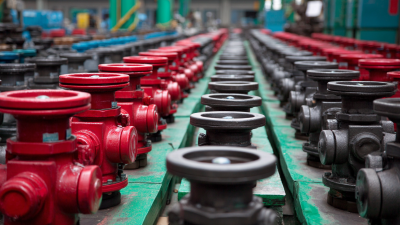
In today's fast-paced industrial environment, achieving optimal operational efficiency is paramount, and one often overlooked yet crucial tool in this endeavor is the sight glass indicator. A sight glass indicator not only enhances the monitoring of fluid levels but also provides real-time insights that can significantly impact decision-making processes. By effectively utilizing sight glass indicators, industries can streamline their operations, reduce downtime, and ensure greater safety in their workflows.

This blog will explore the top strategies for maximizing the potential of sight glass indicators, offering practical tips and best practices that can lead to improved performance and reliability in various industrial applications. Whether you are new to these indicators or looking to refine your existing practices, understanding how to leverage this simple yet effective tool can make a substantial difference in your operational success.
Sight glass indicators play a crucial role in industrial settings by providing vital visual feedback on the status of liquids or gases within a system. These transparent tubes or panels are strategically placed along pipelines or storage tanks, allowing operators to easily monitor fluid levels and detect any anomalies, such as sediment buildup or changes in color, which could signal potential issues. Understanding the functionality of sight glass indicators is essential for effective operation, as they not only enhance safety but also improve overall efficiency.
In addition to visual monitoring, sight glass indicators may come equipped with additional features such as level markers, temperature gauges, or pressure sensors, which further aid in operational decision-making. Regular maintenance and cleaning of sight glasses are crucial to ensure their clarity and accuracy. By effectively utilizing these indicators, industrial facilities can proactively manage their processes, reduce downtime associated with leaks or overflows, and uphold optimal performance standards across various operations. This simple yet impactful tool, when understood and applied appropriately, fosters a reliable and safe working environment.

Sight glass indicators play a crucial role in various industrial operations, providing essential visual feedback on liquid levels and flow conditions. Understanding the key types of sight glass indicators and their applications is paramount for optimizing performance across industries. The market for these indicators in India is projected to grow from $109.58 million in 2025 to $156.29 million by 2032, demonstrating a steady annual growth rate of 5.20%. This increase reflects the growing dependency on effective monitoring tools in manufacturing and processing sectors.
Different types of sight glass indicators are suited for specific industrial applications. For example, transparent sight glasses are commonly used in water and chemical processing plants, allowing for easy verification of liquid visibility. On the other hand, reflex sight glasses offer enhanced visibility for monitoring high-viscosity fluids. When selecting a sight glass indicator, consider factors such as material compatibility with the fluid, pressure ratings, and the ease of maintenance.
**Tips:** Always check the manufacturer's specifications to ensure the selected sight glass indicator meets the operational demands of your processes. Regular maintenance and inspection can prevent leaks and failures, enhancing safety and efficiency in industrial environments. Additionally, integrating advanced technologies, such as AI, can provide predictive maintenance insights, further optimizing the use of sight glass indicators in your operations.
When it comes to utilizing sight glass indicators in industrial operations, installation and maintenance practices play a crucial role in ensuring their effectiveness. Properly installing sight glass indicators involves selecting the right location for visibility while minimizing risks associated with vibration and thermal expansion. According to a report by the American Society of Mechanical Engineers (ASME), over 30% of equipment failures in industrial settings can be traced back to improper installation practices. By adhering to ASME’s recommended installation guidelines, industries can significantly reduce the chances of leaks and failures.
Regular maintenance is equally important for maximizing the lifespan and functionality of sight glass indicators. A study from the International Journal of Industrial Engineering found that routine inspections could lead to a 20% reduction in downtime associated with equipment failures. It is essential to implement a schedule for cleaning and checking seals to prevent residue buildup, which can obscure visibility and lead to inaccurate readings. Additionally, ensuring that all components are regularly tightened and free from wear can enhance the reliability of these indicators, thus supporting overall operational efficiency.
| Dimension | Description | Best Practices | Maintenance Tips |
|---|---|---|---|
| Visibility | Clear view of fluid levels in tanks and pipelines. | Ensure proper positioning for optimal viewing angle. | Regularly clean the glass for unobstructed visibility. |
| Installation Height | Height of sight glass installation affects reading accuracy. | Install at eye level for ease of monitoring. | Check for proper sealing to prevent leaks. |
| Material | Material of sight glass affects durability and visibility. | Choose appropriate materials based on fluid type. | Inspect for scratches or cracks regularly. |
| Temperature Ratings | Ensure sight glass can withstand operational temperatures. | Verify manufacturer specifications before installation. | Monitor surrounding equipment for overheating risks. |
| Pressure Ratings | Sight glass must withstand system pressures. | Consult pressure guidelines during selection. | Regularly check for pressure-induced wear. |
Sight glass indicators are essential tools in industrial operations, providing real-time visual monitoring of fluid levels. However, several challenges can arise in their usage, which can lead to inefficiencies or hazards. One common issue is the risk of contamination, as dirt or other materials can obstruct the view through the glass, potentially leading to inaccurate readings. To mitigate this risk, regularly clean the sight glass and ensure that it is installed in a position that minimizes exposure to contaminants.
Another challenge is the risk of glass breakage due to pressure changes or vibrations in the operating environment. To address this, it's crucial to utilize high-quality materials designed for the specific conditions of your operation. Additionally, implementing vibration dampening mounts can help protect sight glass indicators from mechanical stress.
Tips for optimal performance include using sight glasses made from materials that are resistant to the fluids being monitored and ensuring proper calibration and maintenance protocols are in place. Regular inspections will not only keep the indicators functioning properly but also enhance overall operational safety by preventing issues before they escalate.

In the realm of industrial operations, the integration of sight glass indicators can significantly enhance efficiency and safety. For instance, a manufacturing plant specializing in chemical processing recently implemented sight glass indicators to monitor fluid levels in their storage tanks. By utilizing these transparent gauges, operators were able to instantly assess the liquid levels without opening the tanks, which minimized the risk of contamination and leaks. This real-time visibility led to faster decision-making and reduced downtime, thereby optimizing production hours.
Another exemplary case can be observed in a food processing facility that faced challenges with monitoring ingredient flow. The introduction of sight glass indicators allowed the team to visually confirm the flow of materials, ensuring that the correct quantities were fed into the production line. This not only improved accuracy but also helped maintain quality standards, as operators could quickly identify issues such as clogs or irregular flow rates. The direct feedback provided by the sight glass indicators streamlined their operations and contributed to a more robust quality control process.
This bar chart illustrates various operational metrics influenced by the use of sight glass indicators in industrial settings. Monitoring production efficiency, downtime, maintenance costs, and energy consumption can lead to significant optimization of industrial operations.



